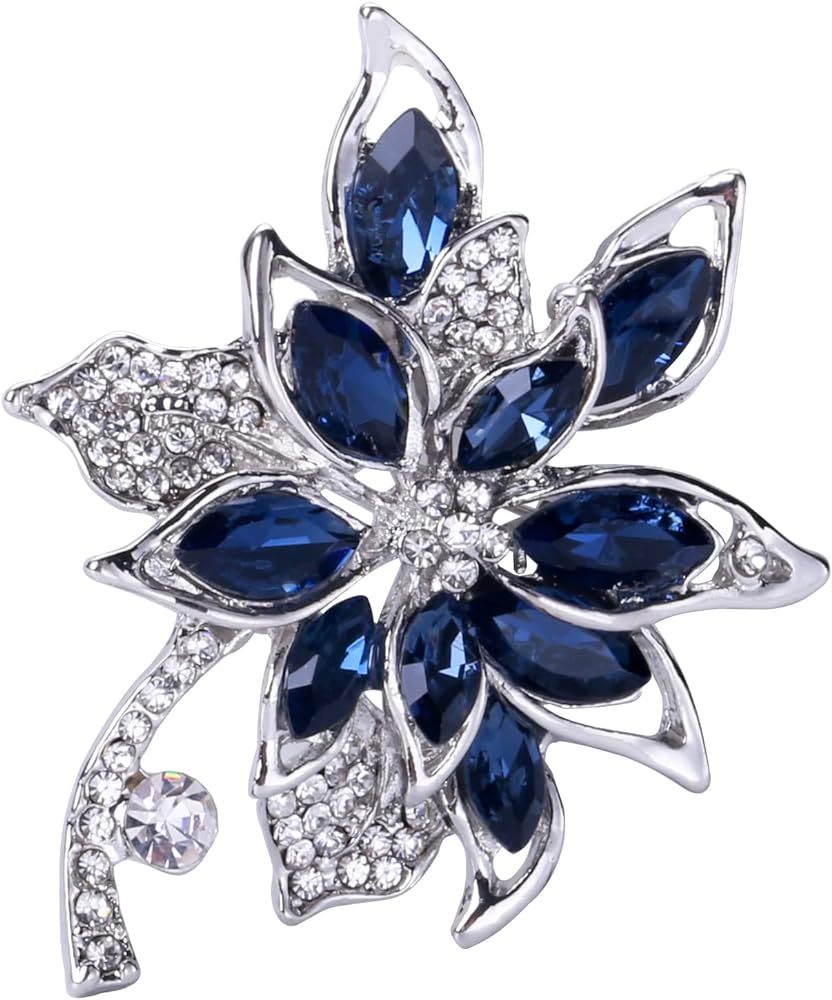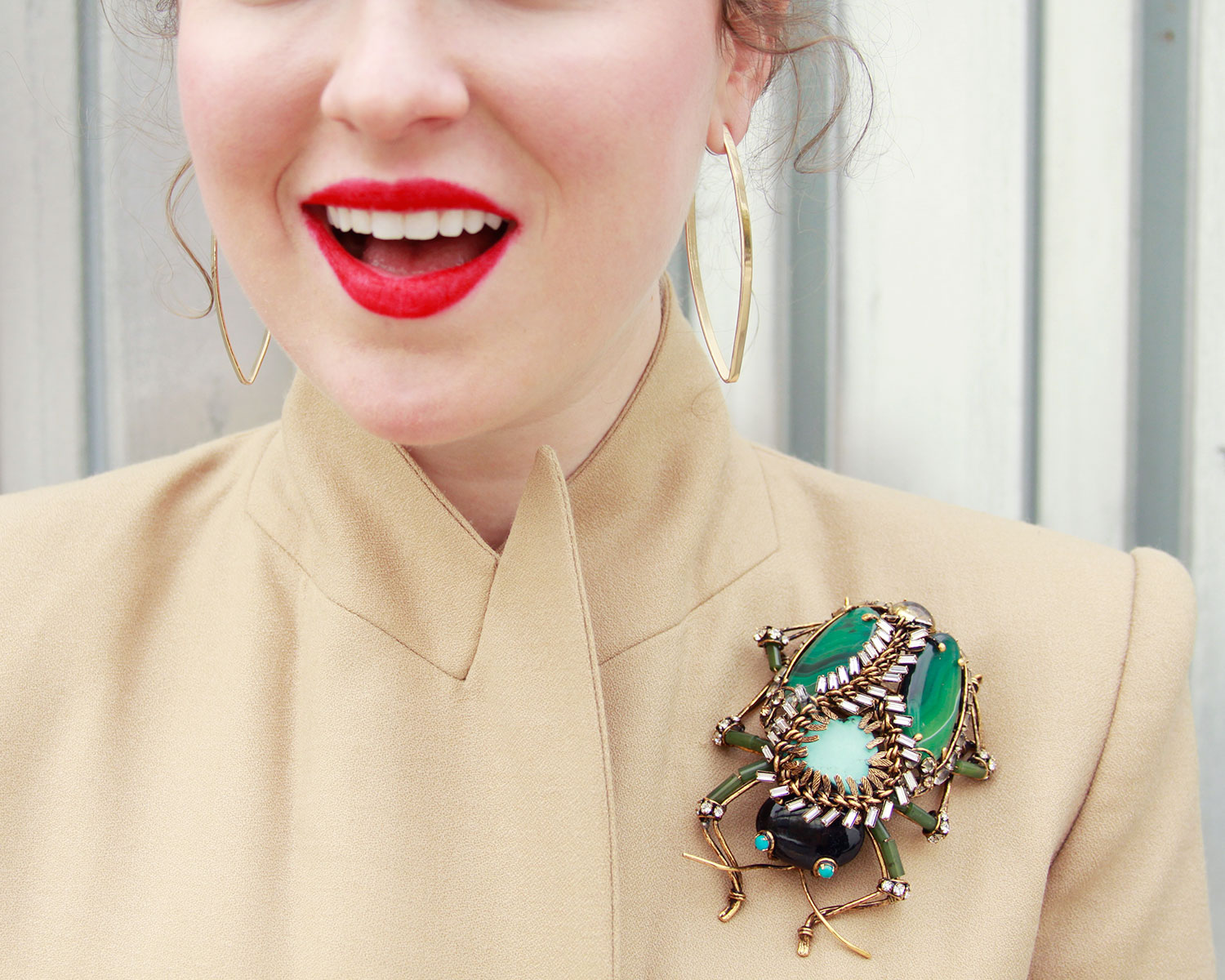I. Introduction
(A) Adorned with Elegance: The Enduring Allure of Brooches and Pins
For centuries, brooches and pins have added a touch of elegance and sophistication to attire. From the functional clasps of ancient times to the artistic masterpieces of today, brooches and pins continue to captivate wearers and collectors alike. Let’s embark on a journey to explore the fascinating world of these timeless treasures.
(B) A Journey Through Time: The History of Brooches and Pins
The history of brooches and pins stretches back millennia. Early evidence suggests they were used as early as the Bronze Age, primarily for functional purposes like fastening garments. The ancient Greeks and Romans employed brooches made of bronze, gold, and even bone to secure togas and cloaks. During the Middle Ages, brooches evolved into elaborate status symbols, often adorned with precious gems and intricate designs. The Renaissance ushered in a new era of artistry, with brooches crafted from enamel, cameos, and pearls becoming highly sought-after fashion statements. The Victorian era witnessed a surge in brooch popularity, with elaborate and sentimental designs reflecting the social and artistic trends of the time. Today, brooches and pins continue to be embraced by fashion designers and worn by individuals seeking to add a touch of timeless elegance or a unique conversation starter to their outfits.

II. Unveiling the Varieties of Brooches and Pins
(A) A Tapestry of Styles: From Classic to Contemporary
The world of brooches and pins offers a dazzling array of styles to suit every taste and occasion. Classic brooches include the timeless cameo brooch, featuring a delicate shell carving often depicting a portrait or mythological scene. Fibulae, the ancient safety pin’s more decorative cousin, remain popular with their simple yet elegant design. Bar pins, featuring a straight pin with a decorative head, offer endless possibilities for design variations. For a touch of whimsy, whimsical brooches in the shape of animals, flowers, or even everyday objects can add a playful touch to an outfit. Contemporary brooches often push the boundaries of design, incorporating avant-garde materials and innovative techniques.
(B) Functional and Fashionable: Exploring the Different Types of Brooches and Pins
Beyond aesthetics, brooches and pins can also serve various functional purposes. Collar pins keep lapels neatly in place, while tie clips add a touch of polish to formal attire. Hat pins secure headwear, and shawl pins hold shawls and scarves securely. Safety pins remain a reliable and versatile tool for quick clothing repairs or creating a makeshift piece of jewelry. With so many styles and functions to choose from, there’s a perfect brooch or pin to complement any outfit or need.

III. Delving into the Craftsmanship of Brooches and Pins
(A) A Symphony of Materials: The Diverse Components of Brooches and Pins
Brooches and pins are crafted from a wide range of materials, each contributing to the piece’s unique aesthetic and value. Precious metals like gold, silver, and platinum form the base for many brooches, while gemstones like diamonds, sapphires, and rubies add a touch of brilliance. Enamel work allows for vibrant colors and intricate designs, while cameos offer a classic elegance with their carved shell depictions. For a more organic touch, brooches can be made from wood, pearls, or even seashells. Modern brooches may incorporate unconventional materials like plastic, glass, or even fabric, pushing the boundaries of design and expression.
(B) Techniques and Traditions: The Art of Creating Brooches and Pins
The creation of brooches and pins involves a variety of traditional and modern techniques. Metalsmithing skills are essential for crafting the base of the brooch from precious metals. Stonesetters meticulously secure gemstones in their settings, ensuring they sparkle and remain secure. Enameling involves applying a powdered glass mixture to the metal and then firing it in a kiln to create a smooth, colorful finish. Cameo carving requires meticulous skill and artistry to transform a shell into a miniature work of art. Modern techniques like laser cutting and 3D printing are also finding their way into brooch making, allowing for intricate designs and unique materials. Regardless of the technique used, creating a brooch or pin is a testament to the skill and artistry of the craftsperson.
IV. Symbolism and Significance: The Deeper Meaning of Brooches and Pins
(A) Beyond Adornment: The Symbolic Language of Brooches and Pins
Brooches and pins can transcend mere decoration, often carrying symbolic meaning or representing a personal connection. They can be passed down through generations, becoming treasured family heirlooms imbued with sentimental value. Military brooches or pins might signify service or honor a fallen soldier. Fraternal or professional organization pins can display affiliation and pride. A brooch depicting an animal might represent the wearer’s spirit animal or a cherished pet. In some cultures, brooches serve as talismans or amulets, believed to bring good luck or ward off evil. By understanding the symbolism behind a brooch or pin, we gain a deeper appreciation for its story and significance.
(B) Cultural Expressions: Brooches and Pins as Reflections of Identity and Heritage
Brooches and pins can also be powerful expressions of cultural identity and heritage. Traditional brooches from different regions may incorporate specific materials, designs, or symbols that reflect the local culture and craftsmanship. For example, Scottish kilt pins (kilt pins) are a vital part of traditional Highland dress. Indian brooches (sarisagam brooch) often feature intricate designs and colorful gemstones, complementing the vibrant sarees they adorn. Hakata pins (Hakata bari) from Japan are known for their delicate embroidery and use of silk threads. By wearing a brooch or pin that reflects their cultural background, individuals connect themselves to their heritage and share a piece of their story with the world.
V. Caring for Your Brooches and Pins: Preserving Their Legacy
(A) Proper Handling and Storage: Ensuring the Longevity of Your Treasures
Due to their delicate nature and potential value, brooches and pins require proper care to maintain their beauty and functionality. Always handle brooches with clean, dry hands to avoid tarnishing or damaging the finish. After wearing, gently wipe your brooch with a soft cloth to remove any dust or oils. Store brooches individually in soft pouches or compartmentalized jewelry boxes to prevent scratches or entanglement. For valuable brooches, professional cleaning by a jeweler may be recommended periodically. By taking proper care of your brooches and pins, you ensure they can be enjoyed for generations to come.
(B) Restoration and Repair: Breathing New Life into Vintage Brooches and Pins
Even with proper care, brooches and pins can experience wear and tear over time. Fortunately, many vintage and antique brooches can be restored or repaired by skilled craftspeople. A jeweler can replace missing stones, tighten loose clasps, or polish a tarnished surface. For more extensive damage, specialist restorers may be able to repair broken pieces or mend delicate cameos.
VI. Brooches and Pins in Fashion: A Timeless Accessory
(A) Accentuating Style: Incorporating Brooches and Pins into Modern Ensembles
Brooches and pins continue to be a relevant and versatile fashion accessory. They can elevate a simple outfit or add a touch of personality to a formal ensemble. A statement brooch on a lapel can add a pop of color or a touch of vintage charm. A delicate pin can add a touch of whimsy to a hat or scarf. A strategically placed brooch can cover a small tear or add visual interest to a plain garment. With a little creativity, brooches and pins can be incorporated into various styles, from classic to contemporary, adding a unique touch to any outfit.
(B) Versatility and Personalization: Expressing Individuality with Brooches and Pins
The beauty of brooches and pins lies in their versatility and ability to reflect personal style. The wide range of styles, materials, and symbolism allows individuals to express their unique personalities and interests. A lover of nature might wear a brooch depicting a butterfly or a flower. An artist might choose a brooch with a bold, abstract design. A brooch collection can tell a story about the wearer’s tastes, experiences, and even heritage.
VII. Brooches and Pins in Collectibles: A Passion for the Past
(A) The Allure of Antiquity: Collecting Vintage and Antique Brooches and Pins
Brooches and pins hold a special allure for collectors, offering a tangible connection to the past and a unique investment opportunity. Vintage and antique brooches can represent different eras and design movements, reflecting the artistic trends and social values of their time. Collectors may seek out pieces by renowned designers, specific historical periods, or even brooches featuring their birthstones or favorite symbols.
(B) Valuing and Appreciating: Understanding the Market for Brooches and Pins
The value of a brooch or pin depends on several factors, including its age, materials, craftsmanship, condition, rarity, and designer. Antique brooches made from precious metals and gemstones by renowned designers can fetch high prices at auctions or from specialist dealers. Understanding the factors that influence value allows collectors to make informed decisions and build a collection they cherish.


